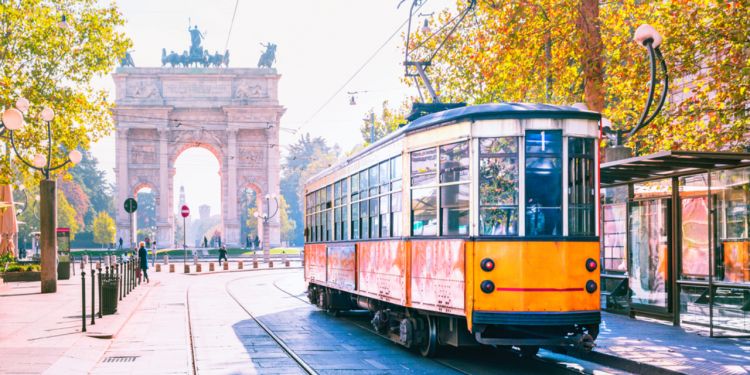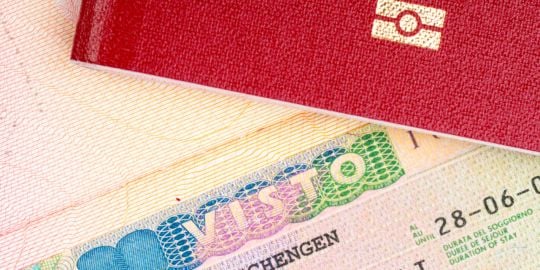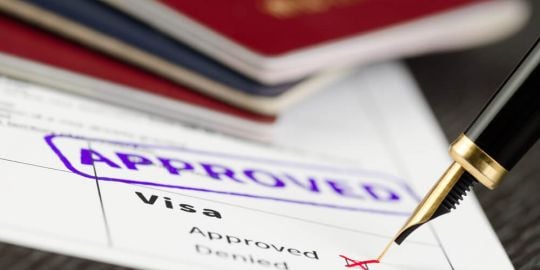Travelling around Italy

Italy operates a reasonably priced, reliable, and efficient train network which spans the whole country and interlinks most major towns and cities. There are three different types of trains in Italy, which vary in price and speed.
- Frecce: high-speed trains which only operate between major cities. Advance seat reservation is essential and prices are significantly higher than Intercity and regional alternatives. There are three different types of Frecce train: Frecciarossa (which connects Turin, Milan, Bologna, Rome, Naples, and Salerno, and reaches speeds of 360km/h), Frecciargento (which connects Rome, Venice, Verona, Bari, Lamezia Terme, and Reggio Calabria, and reaches speeds of 250 km/h) and Frecciabianca (which connects Milan, Venice, Udine, Trieste, Genoa, Rome, Bari, and Lecce, and reaches speeds of 200 km/h).
- Intercity: relatively fast trains which run the length of the country and stop in most cities and large towns. First and second class service is available.
- Regionale: local trains which often run around school and work schedules. These are generally reasonably priced and do not need to be booked in advance.
The Italian railway system is controlled and regularised by Trenitalia. Note that you will need to use the Italian name of your destination, e.g. Roma Termini for Rome. ItaliaRail also offers a multinational service for visitors looking to book tickets online.
Italo is a fast train service which covers the major cities of Italy since 2012. It's quite popular for travelling in Italy, and has interesting offers all year round.
There are also a handful of private rail companies which offer services between towns such as the Ente Autonomo Volturno, running between Naples, Pompeii, and the Amalfi Coast.
Important:
Before boarding your train, you will need to validate your ticket. Find a green and white machine (usually at the entrance or on the binario (platform) which prints the time and date of the use of the ticket. There are high fines for people who fail to validate their ticket.
Bus
Taking the bus in Italy is easy, reliable, and cost-efficient. It also provides services to many towns and cities in areas where trains cannot go and offers a great opportunity to stray off the well-beaten path. There is no national bus network so unfortunately there is no centralised bus service database, but Oraria Autobus contains some useful information on bus schedules in each region, and Check My Bus is a great resource for researching which buses operate in specific towns, cities, and provinces.
Good to know:
You should purchase bus tickets in advance of travelling if possible. You can purchase these on the Internet, from tabacaio, newsstands, and dispensing booths at metro stations.
Important:
Make sure you validate your ticket when you get on the bus. If you don't, you could be fined between â¬50-â¬110.
The Italian coach network is a reliable and cost-efficient way to travel between Italy's regions and cities. Many services also offer air conditioning and free wifi too. The main national coach companies in Italy include Marino Autolinee (linking Naples, Bari, Bologna, Genoa, Milan, Padova, Parma, Turin, and Venice), Autolinee Baltour, and Sena. Additionally, some multinational coach companies like FlixBus offer great value coach routes between larger cities and towns.
Car
If you prefer traveling independently or you plan to move to a smaller city or rural town, you may consider driving in Italy. While driving in Italy has an intimidating reputation, road rules are generally observed, and as long as you have the correct licenses and permits, you shouldn't have any issues. EU driving licenses are recognised in Italy but if you have an international driving license, you will need to exchange this for an Italian driving license. Read our article for details on how to apply for a driving license in Italy and how to drive in Italy.
Italy has an extensive network of roads which include Autostrade, Strade Statalli, Strade regionali, Strade provinciali, and Strade Locali. For more details on traffic conditions and toll costs, consult autostrade.it or read our article on driving in Italy for further details on driving conditions in Italy.
Good to know:
The Zona Traffico Limitato (ZTL), consisting of inner cities and historical cities, is closed to tourist cars due to the narrow roads and lack of parking space.
Car-sharing services
Mopeds and motorbikes
Driving in Italy is not without its disadvantages. Traffic, particularly in big Italian cities, can be frustrating, and finding a parking space can be a lengthy process. For this reason, many Italians and expats choose mopeds and motorbikes as their primary mode of transport. Perhaps one of the most characteristic features of popular culture, mopeds and scooters can weave through traffic and complex terrains.
To drive a moped or motorcycle in Italy you must be at least 14 years old, undertake a training course at a local school, and pass a practical exam.
Bikes
Bikes are also very popular in Italy, especially in the North, and a well-established part of the Italian lifestyle. One of the many advantages of cycling is that you will be able to visit numerous historical places and other tourist attractions where motor traffic is restricted. Bike rental shops are available in all Italian cities.
Good to know :
Taxi
Sometimes, taking a taxi is unavoidable and if you have just arrived in the country, it is often preferable. If you can, you should get a taxi from an official taxi rank. Unregistered taxis operate a notorious service in Italy, charging higher prices and hidden fees. Most taxis do not accept cards so you should also ensure that you have small change and cash with you. Unless you are travelling a long distance, most taxi drivers will not give a set rate in advance, and most cities have pre-set rates by their authorities, so they are not subject to negotiation.
However, you can find taxis with apps like FreeNow, thanks to which the fares are fixed.
Good to know :
Currently, Uber is only available in Rome and Milan. Moreover, the service is different from that provided in other countries as the ride is more or less like in a normal taxi. Regulations are very strict in the country to avoid competition with conventional taxis.
Useful links:
Trenitalia
InterRail
Biccincittà
Oraria Autobus
Check My Bus
FlixBus
Autostrade.it
Marino Autolinee
Autolinee Baltour
Sena









